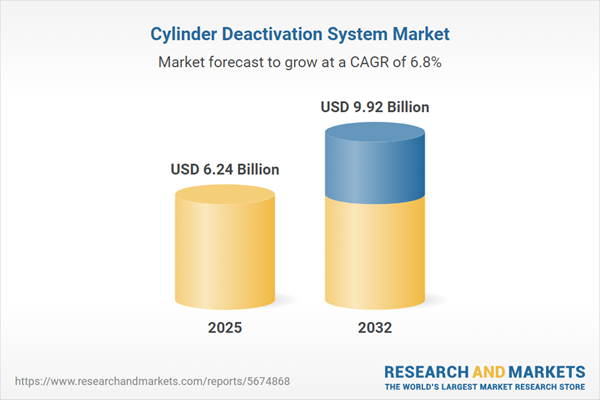Speak directly to the analyst to clarify any post sales queries you may have.
The cylinder deactivation system market is at the forefront for automotive enterprises seeking efficient answers to regulatory demands and sustainability targets. By updating existing fleets and innovating for new production, leading organizations are integrating advanced solutions to keep pace with an evolving mobility landscape, manage compliance, and drive operational value.
Cylinder Deactivation System Market Snapshot
The cylinder deactivation system market is projected to expand from USD 5.84 billion in 2024 to USD 6.24 billion in 2025, demonstrating a compound annual growth rate (CAGR) of 6.84%. Rapid adoption is taking place as automakers and fleet operators respond to evolving regulatory incentives and tightening emissions requirements. Next-generation cylinder control technologies are key drivers, supporting organizations in achieving lower environmental impact and contributing to improved engine performance. The continuous evolution of engine intelligence widens the possibilities for optimizing vehicle operations and aligning with sustainability priorities. Investment in these solutions is being recognized as a central factor for long-term compliance and competitiveness among senior automotive leaders.
Scope & Segmentation of the Cylinder Deactivation System Market
- Vehicle Types: Solutions cater to heavy commercial vehicles, light commercial vehicles, and passenger cars, supporting distinct use cases and compliance needs across fleet categories.
- Engine Types: Both diesel and gasoline engines can benefit from tailored cylinder deactivation systems, helping organizations align specific powertrains with emission and efficiency targets.
- Cylinder Count: Compatibility with four-, six-, and eight-cylinder engines offers flexibility to meet various vehicle performance strategies and resource allocations.
- Actuation Methods: Electronic valve actuation, including solenoid and piezoelectric systems, as well as hydraulic solutions, provide integration options suitable for today’s diverse engine architectures.
- Sales Channels: The market supports both OEM deployments and aftermarket retrofits, giving enterprises access to cylinder deactivation systems whether upgrading existing fleets or specifying new vehicles.
- Geographic Regions: Adoption strategies differ across the Americas, Europe, Middle East & Africa, and Asia Pacific, as organizations tailor solutions to local regulatory frameworks, operational costs, and compliance expectations.
- Key Players: Sector progress is advanced by organizations including BorgWarner Inc., Continental AG, Robert Bosch GmbH, MAHLE GmbH, Schaeffler AG, Tenneco Inc., Cummins Inc., Ford Motor Company, Delphi Technologies, and Eaton Corporation plc, who drive innovation through collaboration and technology development.
Cylinder Deactivation System Market: Key Takeaways for Senior Decision-Makers
- Proactive engine management strategies streamline compliance activities and improve operational fleet efficiency, especially under real-time market shifts.
- Modern electronic controls enable seamless deployment of cylinder deactivation systems across both new vehicles and legacy fleets, promoting accelerated upgrades without full platform replacements.
- Increased collaboration among OEMs, suppliers, and technology partners helps organizations quickly respond to regulatory changes and shrinks development cycles.
- Integrating these systems with hybrid powertrain and advanced data analytics solutions allows for enhanced operational flexibility and benchmarking of fleet performance.
- Readily available aftermarket calibration tools enable organizations to adapt varied vehicle assets, reducing the need for large-scale overhauls and simplifying ongoing fleet management.
Tariff Impact: Navigating Supply Chain Complexities
Expected tariff adjustments in 2025 are projected to introduce new volatility into electronic and hydraulic component pricing within the cylinder deactivation system market. In response, leading market participants are prioritizing expanded sourcing networks and investing in nearshore manufacturing capabilities. These adjustments help reduce exposure to global supply chain disruptions. At the same time, tighter inventory controls and stronger supplier relationships are essential to support compliance with new U.S. regulations and protect smooth business operations during transition periods.
Methodology & Data Sources
This analysis consolidates insights from engineering, procurement, and regulatory teams, complemented by technical documentation, patent reviews, and expert workshops. The approach is structured to guarantee that all findings are relevant and validated for executive strategy and investment decisions.
Why This Report Matters
- Offers in-depth benchmarking and market landscape analysis, equipping organizations to direct resources toward the highest-impact areas in an evolving regulatory environment.
- Provides frameworks for managing risks related to supply chains and regulatory changes, promoting operational resilience and business continuity in unpredictable conditions.
- Identifies the primary drivers of growth for enhanced cross-functional collaboration and ensures sector development is robust and sustainable.
Conclusion
Deploying cylinder deactivation systems enables organizations to boost efficiency, prepare for regulatory shifts, and realize measurable sustainability outcomes. Strategic technology decisions in this market support continual adaptation and long-term organizational value.
Additional Product Information:
- Purchase of this report includes 1 year online access with quarterly updates.
- This report can be updated on request. Please contact our Customer Experience team using the Ask a Question widget on our website.
Table of Contents
3. Executive Summary
4. Market Overview
7. Cumulative Impact of Artificial Intelligence 2025
Companies Mentioned
The companies profiled in this Cylinder Deactivation System market report include:- BorgWarner Inc.
- Continental AG
- Robert Bosch GmbH
- MAHLE GmbH
- Schaeffler AG
- Tenneco Inc.
- Cummins Inc.
- Ford Motor Company
- Delphi Technologies
- Eaton Corporation PLC
Table Information
| Report Attribute | Details |
|---|---|
| No. of Pages | 184 |
| Published | November 2025 |
| Forecast Period | 2025 - 2032 |
| Estimated Market Value ( USD | $ 6.24 Billion |
| Forecasted Market Value ( USD | $ 9.92 Billion |
| Compound Annual Growth Rate | 6.8% |
| Regions Covered | Global |
| No. of Companies Mentioned | 11 |









